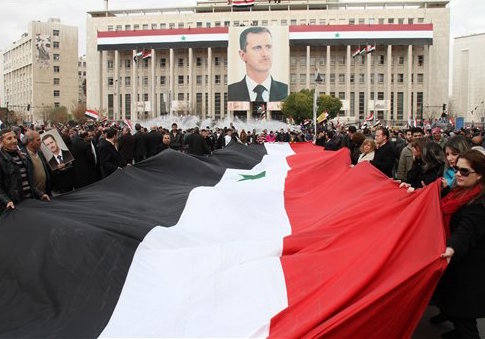A Syrian artist who was twice imprisoned by President Bashar al-Assad’s regime for allegedly being an opposition activist recounted the state of the detention center in which he was held.
The artist told BBC that each 3 x 4-meter (about 10 x 13 feet) cell in the detention facility was filled with almost 70 prisoners and that prison officials piled dead bodies into the cells.
"They used to bring the bodies from the basement and pile them in front of us," the artist said.
"Every day there would be about eight new bodies. After a week I managed to get closer and count the number written on a body’s forehead. It was 5,530--and after a month and a half, the number on another body was 5,870. I got used to it."
"The first night I saw a dead body and smelled it, I felt so sick and sad I couldn’t sleep," he continued. "But later on, we were eating while a dead body was next to us. I remember leaning on a dead body and thinking, ‘When are they going to remove it so I can have more space?’"
The artist, who was detained twice, said that 40 members of his family have been killed by the Assad regime. He said that his "modern" appearance, in addition to belonging to a family and religious group that pushed back against Assad’s rule, prompted his arrest.
"I had long curly hair when I was detained for first time. This modern look was a sign for the government that I belong to the coordination committees that organized protests. The security officer dragged me by my hair and told his boss, ‘We’ve got one of the coordinators sir,’" the artist recounted.
The former prisoner said that he was blindfolded by police and taken to a room where his hands were bound with wires.
"They started beating me up madly. Then I reached the detention centre. I was bleeding, bones broken, ears damaged so that I couldn’t hear properly. The place was like Dante’s inferno. You are constantly tortured and you hear the cries of people being tortured. I was kept in the basement maybe seven stories down," the artist recalled.
He and his family spent $15,000 in bribes to get him released from prison. The artist, who eventually escaped Syria, also pushed back on the Syrian government’s claim that it is fighting radical Islamic terrorist groups like ISIS.
"I didn’t see any Islamists or jihadists or radicals in prison. I just saw ordinary Syrians. Needless to say, almost everyone in prison is Sunni," the artist said.
The firsthand account of the Syrian government’s detention facilities comes just days after the United States, Russia, and other world powers met in New York and rallied behind a peace process in Syria that involves political talks and new elections.
However, the plan agreed to at the United Nations Security Council does not specify whether Assad can run in the new elections, which are to be held 18 months after political talks begin.
Ahead of the meeting in New York, Secretary of State John Kerry met with Russian President Vladimir Putin to discuss Syria, ISIS, and other topics. Following the conversation, Kerry said that the Obama administration is not seeking a "regime change" in Syria, despite the fact that President Obama has long argued that Assad must be removed from power for peace to be achieved in Syria.
Instead, Kerry said, the U.S. and other world powers are focused on achieving a peace process during which "Syrians will be making decisions for the future of Syria."
Russia, a strong ally of Assad, has insisted that the Syrian people decide Assad’s fate.
